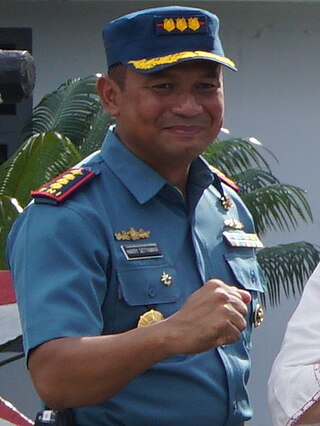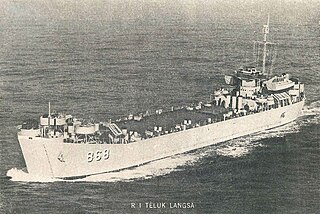
The Indonesian Navy is the naval branch of the Indonesian National Armed Forces. It was founded on 10 September 1945 and has a role to patrol Indonesia's lengthy coastline, to enforce and patrol the territorial waters and Exclusive Economic Zone (EEZ) of Indonesia, to protect Indonesia's maritime strategic interests, to protect the islands surrounding Indonesia, and to defend against seaborne threats.

KRI Alamang (644) is a Clurit-class fast attack craft of the Indonesian Navy. Commissioned in 2013, she is the fourth ship of her class.

KDB Waspada (P-02) / KRI Salawaku (842) is the second ship of Waspada class built up in the late 1970s, one of three ordered in Singapore. She was launched in 1977, and was in service with the Royal Brunei Navy until 2011, when she was sold to the Indonesian Navy. She is currently active in Indonesia service as KRI Salawaku.

Commodore Harry Setyawan was a naval officer who held several different commands in the Indonesian Navy, culminating in being Commander of the 2nd Fleet Submarine Unit. He died in the sinking of the KRI Nanggala.

KRI Teluk Amboina is a tank landing ship (LST) of the Indonesian Navy. The ship was built at Sasebo Heavy Industries, Japan and completed in 1961. Its design is a copy of LST-542-class LST, albeit faster than the original. As of 2020, Teluk Amboina is the oldest ship in commission with the Indonesian Navy.

USS LST-678 was an LST-542-class tank landing ship built for the United States Navy during World War II. Later she was converted to Benewah-class barracks ship as USS Presque Isle (APB-44), named after Presque Isle County, Michigan. She was acquired by Indonesian Navy in 1967 as KRI Teluk Ratai (509) and decommissioned in 2019. She is planned to be preserved as museum ship.

USS Solano County (LST-1128) was a LST-542-class tank landing ship in the United States Navy during World War II. She was transferred to the Indonesian Navy as KRI Teluk Langsa.
KRI Teluk Kendari (518) is the first Teluk Bintuni-class tank landing ship of the Indonesian Navy.
KRI Teluk Kupang (519) is the second Teluk Bintuni-class tank landing ship of the Indonesian Navy.

KRI Teluk Wondama (527) is the ninth Teluk Bintuni-class tank landing ship of the Indonesian Navy.

KRI Teluk Hading (538) was a Frosch-class landing ship operated the Indonesian Navy. The ship was former Cottbus of the Volksmarine.

KRI Teluk Berau (534) was a Frosch-class landing ship operated the Indonesian Navy. The ship was former Eberswalde-Finow of the Volksmarine.

KRI Teluk Jakarta (541) was a Frosch-class landing ship operated the Indonesian Navy. The ship was former Eisenhüttenstadt (615) of the Volksmarine.

The Military Sealift Command, is an organization that controls the replenishment and military transport ships of the Indonesian Navy. Military Sealift Command has the responsibility for providing sealift and ocean transportation for all Indonesian military services as well as for other government agencies. It first came into existence on 1 July 1961 when the Naval Transport Department was established as the sole service responsible for the Ministry of Defense's ocean transport requirements for both peacetime and war.

KRI dr. Radjiman Wedyodiningrat (992) is the second ship of the Sudirohusodo-class hospital ships of the Indonesian Navy. The ship was named after an Indonesian national hero Rajiman Wediodiningrat.

The 1st Fleet Patrol Ship Force is part of the Indonesian 1st Fleet Sea Security Group Operations Unit and the Command for operational development under the 1st Fleet Command. The 1st Fleet Patrol Ship Force is responsible for developing the strength and combat capability of at least 32 warships under its command in the fields of maritime security, limited surface warfare, and limited air defense warfare. It also conducts personnel development to improve the skills and professionalism of its soldiers, as well as training development to enhance the combat readiness of its elements.

The 1st Fleet Amphibious Ship Force is part of the Indonesian 1st Fleet Sea Security Group and the Command for operational development under the 1st Fleet Command. This unit has the primary function of serving as the first strike force or neutralizing enemy surface ships attempting to violate maritime law, launch attacks, or carry out invasions. In addition, it also functions as air defense against enemy attacks, reconnaissance, and target search operations, as well as conducting electronic warfare.















